User:Peterstrempel/Soviet-Brezhnev-draft
| This is not a Wikipedia article: It is an individual user's work-in-progress page, and may be incomplete and/or unreliable. For guidance on developing this draft, see Wikipedia:So you made a userspace draft. Find sources: Google (books · news · scholar · free images · WP refs) · FENS · JSTOR · TWL |
![]() Draft abandoned 10 March 2011
Draft abandoned 10 March 2011
| Politics of the Soviet Union |
|---|
 |
|
|
| ||
|---|---|---|
|
First, then General Secretary of the CPSU
Foreign policy Media gallery |
||
The history of the Soviet Union (1964 1982), also known as the Brezhnev Era after Khrushchev successor Leonid Brezhnev (1906-1982), began at the height of the Cold War, with high economic growth and prosperity, and ended with social, political, and economic stagnation, widespread corruption, and a return to Stalinist repression of dissidence.
The sometimes tense relationship between the Union of Soviet Socialist Republics (USSR) and the West under Khrushchev became more cordial, particularly though the deliberate policy of détente - restraint and compromise - practiced by the collective Soviet leadership, which aged into a gerontocracy during this period.
Politics
Collective leadership
| History of Russia |
|---|
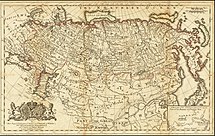 |
|
|
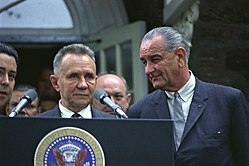
Brezhnev moved to oust Podgorny from the collective leadership in 1970 because technically Podgorny was senior to him in the diplomatic hierarchy, but Brezhnev could not muster the numbers, and Podgorny's conservatism gained him greater influence in the early 1970s against Brezhnev's more liberal stance on
Towards the end of Brezhnev's life he was considered too old by some of his colleagues to carry out the functions of head of state, and the Supreme Soviet established a new position, First Deputy Chairman of the Presidium of the Supreme Soviet, akin to a vice presidential role, appointing 76 year-old
Defence policy
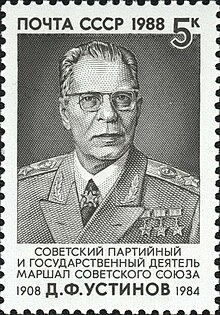
Pursuing a policy of increasing military expenditure from 1965, the Soviet Union achieved nuclear parity with the United States of America (USA) in the early 1970s and then switched to a rapid expansion of its conventional forces based on the strategic doctrine that it could beat the West in a war only by a rapid conquest of Western Europe, relying on sheer numbers of men and materiel to win. Western responses to the military build-up led the Soviet leadership to believe that the military, and the military alone, 'bought the Soviet Union security and influence'.[18]
At the 23rd Party Congress in 1966 Brezhnev told the delegates that the Soviet military had reached a level fully sufficient to defend itself, having reached nuclear Intercontinental Ballistic Missile (ICBM) parity with the USA that year.[19] In early 1977, Brezhnev told the world that the Soviet Union did not seek to become militarily superior to the USA.[20] In the later years of Brezhnev's reign it became official defence policy to invest only enough to maintain national security through a policy of deterrence.[21] In his last meeting with Soviet military leaders in October 1982, Brezhnev stressed the importance of not over-investing in the Soviet military. Despite some differences of opinion in the Soviet leadership, this policy was retained under the leadership of Brezhnev successors Yuri Andropov, Konstantin Chernenko and Mikhail Gorbachev.[22]
According to some of his close advisers, Brezhnev had been concerned about growing military expenditure in the 1960s, bringing him into conflict with Minister of Defence, Marshal Andrei Grechko. In the early 1970s Brezhnev attended a five-hour meeting to try to convince the Soviet military establishment to reduce military spending.[23] In the meeting Brezhnev asked why the Soviet Union should 'continue to exhaust' the economy if the country could not be promised a military parity with the West, a question left unanswered.[24]
When Grechko died in 1976, Dmitriy Ustinov replaced him as defence minister. Ustinov blocked attempts by Brezhnev to reduce national military expenditure.[21]
Brezhnev approved the Soviet intervention in Afghanistan just as he had previously approved the Warsaw Pact invasion of Czechoslovakia.[25] Soviet diplomat Georgy Arbatov noted that the military-industrial complex functioned as Brezhnev's power base within the Soviet hierarchy,[26] and in Brezhnev’s later years he lacked the 'will and energy' to reduce defence expenditure, due to his declining health.[26]
Stabilisation

Committed to a policy of 'stability of cadres',
Initially Brezhnev portrayed himself as a moderate, not as radical as Kosygin but not as conservative as Shelepin. Early in his leadership Brezhnev spent considerable time seeking advice from provincial party secretaries. He gave the Central Committee formal permission to initiate Kosygin's 1965 economic reform. [30]
In the late 1960s Brezhnev talked of the need to "renew" the party cadres, but according to historian Robert Service, his 'self-interest discouraged him from putting an end to the immobilism he detected. He did not want to risk alienating lower-level officialdom.'[31] The Politburo saw the policy of stabilisation as the only way to avoid returning to Stalinist purges and Khrushchev's centralisation of authority. The CPSU was optimistic that a policy of stabilisation would prove to the world the 'superiority of communism'.[31] The Soviet leadership was not entirely opposed to reform, even if the reform movement had been weakened in the aftermath of Soviet suppression of the Prague Spring in the Czechoslovak Socialist Republic.[30] The stabilisation policy also had the effect of reducing cultural freedom, and several dissident samizdats were banned.[32]
Gerontocracy
The reshuffling process of the Politburo ended in the mid-to-late 1970s. In the period that followed, the Soviet leadership evolved into a gerontocracy (a form of rule in which the rulers are significantly older than most of the adult population) in the 1970s.[29]
The Brezhnev generation — people who lived and worked during the Brezhnev Era — owed their rise to prominence to Joseph Stalin's Great Purge in the late 1930s. In the purge Stalin ordered the execution or exile of nearly all Soviet bureaucrats over the age of 35. Stalin's purge opened up posts and offices for a younger generation of Soviets. This generation would rule the country from the aftermath of Stalin's purge up to Mikhail Gorbachev's rise to power in 1985. The majority of these appointees were of either peasant or working class origin. Mikhail Suslov, Alexei Kosygin, and Brezhnev are prime examples of men appointed in the aftermath of Stalin's Great Purge.[33]
The average age of the Politburo's members was 58 years in 1961, and 71 in 1981. A similar greying also took place in the Central Committee, the median age rising from 53 in 1961 to 62 in 1981, with the proportion of members older than 65 increasing from 3 percent in 1961 to 39 percent in 1981. The difference in the median age between Politburo and Central Committee members can be explained by the fact that the Central Committee was consistently enlarged during Brezhnev's leadership; this made it possible to appoint new and younger members to the Central Committee without retiring some of its oldest members. Of the 319-member Central Committee in 1981, 130 were younger than 30 when Stalin died in 1953.[34]
Young politicians, such as
New constitution

Brezhnev was the Chairman of the Constitutional Commission of the Council of Ministers, which worked for the creation of a new constitution. The Commission had 97 members, with
During the drafting process a debate within the Soviet leadership took place between the two factions on wether to call
Later years
In his later years Brezhnev developed a
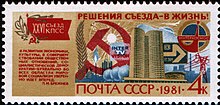
Brezhnev approved the
Brezhnev stayed in office under pressure from some of his Politburo associates, though in practice the country was not governed by Brezhnev any more, but instead by a collective leadership led by Suslov, Ustinov, Gromyko, and
Economics
Early years
The
Brezhnev gave the
Era of Stagnation
| Period | GNP (according to the CIA )
|
GNP (according to Grigorii Khanin) |
GNP (according to the USSR) |
|---|---|---|---|
| 1960–1965 | 4.8[51] | 4.4[51] | 6.5[51] |
| 1965–1970 | 4.9[51] | 4.1[51] | 7.7[51] |
| 1970–1975 | 3.0[51] | 3.2[51] | 5.7[51] |
| 1975–1980 | 1.9[51] | 1.0[51] | 4.2[51] |
| 1980–1985 | 1.8[51] | 0.6[51] | 3.5[51] |
The
1973 reform
Kosygin initiated the
1979 reform
Kosygin initiated the
Five-Year Plans
Foreign relations
Soviet – First World relations

Alexei Kosygin, the Soviet Premier, tried to challenge Brezhnev on the rights of the General Secretary to represent the country abroad, a function Kosygin believed should fall into the hands of the Premier, as was common in non-communist countries. This was actually implemented for a short period.[59] Kosygin, who had been the chief negotiator with the First World during the 1960s, was hardly to be seen outside the Second World[60] after Brezhnev strengthened his position within the Politburo.[59] However, Kosygin headed the Soviet Glassboro Summit Conference delegation in 1967 with Lyndon B. Johnson, the President of the United States. The summit was dominated by three issues; the Vietnam War, the Six-Day War and the Soviet–American arms race. Right after the summit at Glassboro Kosygin headed the Soviet delegation to Cuba, there he met an angry Fidel Castro who accused the Soviet Union of "capitulationism".[61]
The Soviet leadership's policy of

Détente, literally the easing of strained relations, or in Russian, "unloading", meant "ideological co-existence" in Soviet foreign policy context.
The Soviet Union sought an official acceptance of the state borders drawn up in post-war Europe by the United States and Western Europe. In this the Soviets were largely successful; some small differences were that state borders were "inviolable" rather than "immutable"; meaning that borders can be changed only without military interference, or interference from another country.
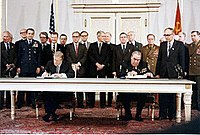
Another blow to Soviet communism in the First World came with the establishment of the eurocommunist movement. Eurocommunists espoused and supported the ideals of Soviet communism but at the same time supporting rights of the individual.[67] The largest obstacle was that it was the largest communist parties, those with highest electoral turnout, which became eurocommunists. It was the Prague Spring which initiated this new thinking, and made them more skeptical of Soviet communism in general.[68]
Soviet–First World relations deteriorated when the United States President
Sino–Soviet relations
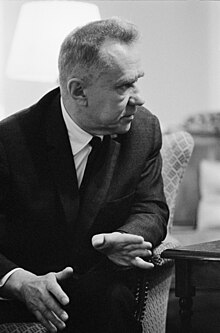
In the aftermath of Khrushchev's ouster and the
When Kosygin told Brezhnev that it was time to reconcile with the PRC, Brezhnev replied: "If you think this is necessary, then you go by yourself". Kosygin was afraid that the PRC would turn down his proposal for a visit, therefore he decided to stop off in
Both Khrushchev and Brezhnev were derided as "betrayers of
Soviet – Eastern Bloc relations
The Soviet leadership's policy towards the
Not all reforms were supported by the Soviet leadership, and
When forces that are hostile to socialism try to turn the development of some socialist country towards capitalism, it becomes not only a problem of the country concerned, but a common problem and concern of all socialist countries.
— Brezhnev, Speech to the Fifth Congress of the Polish United Workers' Party in November 1968[88]
With Willy Brandt's ascension to the West German chancellorship, West German – Soviet tension started to ease. Brandt's Ostpolitik, along with Brezhnev's détente, policy contributed to the signing of the Moscow and Warsaw Treaty in which West Germany recognised the state borders established following World War II, which included West German recognition of East Germany as an independent state. The foreign relations of the two countries continued to improve during Brezhnev's rule, and in the Soviet Union, where the memory of German brutality during World War II was still remembered, contributed to greatly reducing the animosity the Soviet people felt towards Germany, and Germans in general.[62]
On 25 August 1980 the Soviet Politburo established a commission chaired by
Soviet – Third World relations
Since 1975, after the
Soviet influence in
The Soviet Union played a key role in the secessionist struggle against the Portuguese Empire and the struggle for black majority rule in Southern Africa.[98] Control of the Somali Democratic Republic was of great interest to both the Soviet Union and the United States due to the country's strategic location at the mouth of the Red Sea. After the Soviets broke foreign relations with Siad Barre's regime in Somalia, the Soviets turned to Derg Government in Ethiopia and supported them in their war against Somalia. Because the Soviets changed their allegiance, Barre expelled all Soviet advisers, tore up his friendship treaty with the Soviet Union, and switched allegiance to the West. The United States took the Soviet Union's place in the 1980s, in the aftermath of Somalia's loss in the Ogaden War.[99]
Dissident movement
The
| "Every time when we speak about Solzhenitsyn as the enemy of the Soviet regime, this just happens to coincide with some important [international] events and we postpone the decision." |
| — Andrei Kirilenko, a Politburo member.[106] |
The dissident movement had spurts of activity, and during the
Many dissidents, and a number of radical reformers, became members of the Communist Party instead of protesting actively against the Soviet system instead. These dissidents were defined by
Soviet society
Ideology and beliefs
Soviet society under Brezhnev's rule had evolved into a modern society. As noted by Edwin Bacon and Mark Sandle in their book Brezhnev Reconsidered, "a social revolution" was taking place in the Soviet Union during his 18-year long reign.[112] The increasingly modernised Soviet society was becoming more urban, and people were becoming more educated and professionalised. The Brezhnev Era saw, in contrast to previous periods, a continuous development without interruption. In previous years development had been halted by "terrors, cataclysms and conflicts".[112] There was a fourfold growth in higher education between the 1950s and 1980s; this development was referred to as the "scientific-technological revolution".[112] Women also came to make up half of the country's educated specialists.[112]
Following
Culture
During the Brezhnev Era, pressure from below forced the Soviet leadership to alter some cultural policies, however, fundamental characteristics of the Communist system remained the same. Within the realm of popular culture the Soviet leadership was forced to alter it's policies on Western culture, and
Standard of living

Before 1973, the GDP per head in
When the USSR's economic growth stalled in the 1970s, the
During the Brezhnev era there were material improvements for the Soviet citizen, while the
While some areas improved during the Brezhnev era, the majority of civilian services deteriorated, with the physical environment for the common Soviet citizen falling apart rapidly. Diseases were on the rise[127] because of the decaying healthcare system. The living space remained rather small by First World standards, with the common Soviet person living on 13.4 square metres. At the same time thousands of Moscow inhabitants were homeless, most of them living in shacks, doorways and parked trams. Nutrition ceased to improve in the late 1970s, while rationing of staple food products returned to Sverdlovsk for instance.[129]
The state provided daily recreation and annual holidays for hard-working citizens.
Social "rigidification" became a common feature in Soviet society. During the
Historical assessments
Despite Brezhnev's failures in domestic reforms, his foreign affairs and defense policies turned the Soviet Union into a
Notes
- ^ Kenez 2006, p. 210.
- ^ Baylis 1989, p. 97.
- ^ Kenez 2006, pp. 207–208.
- ^ Barron 1975, pp. 10–11.
- ^ Kenez 2006, p. 214.
- ^ Hanson 1975, p. 297.
- ^ Cocks, Daniels & Heer 1997, pp. 56–57.
- ^ Bacon & Sandle 2002, p. 54.
- ^ Brown 2009, p. 403.
- ^ Daniels 1998, p. 36.
- ^ "Soviet Union: Whoa, Comrade Brezhnev". Time. 6 December 1971. p. 1. Retrieved 14 February 2011.
- ^ Hanson 1975, p. 309.
- ^ "Soviet Union: And Then There Was One". Time. 3 November 1980. Retrieved 14 February 2011.
- ^ Brown 2009, p. 402.
- ^ Zemtsov 1989, p. 119.
- ^ "Soviet Union: Veep in Moscow". Time. 17 October 1977. Retrieved 25 February 2011.
- ^ Evangelista 2002, p. 152.
- ^ Frank 1992, p. 9.
- ^ Frank 1992, p. 182.
- ^ Frank 1992, p. 46.
- ^ a b Frank 1992, p. 240.
- ^ Frank 1992, p. 200.
- ^ Evangelista 2002, p. 178.
- ^ Evangelista 2002, p. 178-179.
- ^ a b c Brown 2009, p. 398.
- ^ a b Evangelista 2002, p. 181.
- ^ Service 2009, pp. 404–405.
- ^ a b Bacon & Sandle 2002, p. 11.
- ^ a b Bacon & Sandle 2002, p. 12.
- ^ a b c d Service 2009, p. 380.
- ^ a b Service 2009, p. 392.
- ^ Service 2009, p. 380-381.
- ^ Daniels 1998, pp. 52–53.
- ^ Daniels 1998, p. 53.
- ^ Wesson 1978, p. 252.
- ^ a b Bacon & Sandle 2002, p. 19.
- ^ Zemtsov 1989, pp. 97–98.
- ^ Sharlet 1992, p. 18.
- ^ Sharlet 1992, pp. 18–19.
- ^ Sharlet 1992, p. 19.
- ^ Sharlet 1992, p. 20.
- ^ Sharlet 1992, p. 21.
- ^ a b Service 2009, p. 403.
- ^ Brown 2009, p. 404.
- ^ Brown 2009, p. 405.
- ^ Service 2009, p. 404.
- ^ Service 2009, p. 426.
- )
- )
- ^ "Алексей Гвишиани: «Не надо жалеть Косыгина!»" (in Russian). Pravda Online. 9 April 2004. Retrieved 4 September 2010.
{{cite web}}: Unknown parameter|trans_title=ignored (|trans-title=suggested) (help) - ^ a b c d e f g h i j k l m n o Bacon & Sandle 2002, p. 40.
- ^ a b Bacon & Sandle 2002, pp. 1–2.
- ^ a b Bacon & Sandle 2002, p. 45.
- ^ Dellenbrant 1986, p. 75.
- ^ a b ютуба, любитель (17 December 2010). "30 лет назад умер Алексей Косыгин". Newsland (in Russian). Retrieved 29 December 2010.
{{cite web}}: Unknown parameter|trans_title=ignored (|trans-title=suggested) (help) - )
- ISBN 978–0765602644.)
{{cite book}}: Check|isbn=value: invalid character (help)CS1 maint: multiple names: authors list (link - ^ Dellenbrant 1986, p. 112.
- ^ ISBN 978–1844670163.)
{{cite book}}: Check|isbn=value: invalid character (help)CS1 maint: multiple names: authors list (link - ^ Wesson 1978, p. 248.
- ISBN 978–0691006350.)
{{cite book}}: Check|isbn=value: invalid character (help)CS1 maint: multiple names: authors list (link - ^ a b Brown 2009, p. 399.
- ^ a b Brown 2009, p. 460.
- ^ Brown 2009, pp. 460–461.
- ^ a b c d Brown 2009, p. 461.
- ^ Brown 2009, pp. 462–463.
- ^ Brown 2009, pp. 464–465.
- ^ Brown 2009, p. 465.
- ^ )
- ^ a b Lüthi 2008, p. 288.
- ^ Lüthi 2008, p. 290.
- ^ Radchenko 2009, p. 131.
- ^ Radchenko 2009, pp. 132 and 134.
- ^ a b Radchenko 2009, p. 144.
- ^ Lüthi 2008, p. 293.
- ^ Lüthi 2008, p. 294.
- ^ a b Radchenko 2009, p. 145.
- ^ Radchenko 2009, p. 146.
- )
- ^ Low 1976, p. 320.
- ^ a b Low 1976, p. 321.
- ^ Low 1976, p. 322.
- ^ Service 2009, pp. 385–386.
- ^ Service 2009, p. 385.
- ^ a b Service 2009, p. 386.
- ^ Service 2009, p. 387.
- ^ Service 2009, p. 388.
- ^ )
- ^ a b Brown 2009, p. 430.
- ^ a b Brown 2009, p. 431.
- ^ a b Brown 2009, p. 432.
- ^ Brown 2009, p. 433.
- ^ Brown 2009, p. 435.
- ^ Donaldson 1981, p. 5.
- ^ Donaldson 1981, p. 1.
- ^ Donaldson 1981, p. 2.
- ^ Donaldson 1981, p. 3.
- ^ Donaldson 1981, p. 69.
- )
- ^ Loth 2002, pp. 85–86.
- ^ Loth 2002, p. 86.
- ^ Donaldson 1981, p. 255.
- ^ Kort 2010, p. 325.
- ^ Kort 2010, pp. 325–326.
- ^ a b Kort 2010, p. 328.
- )
- ^ a b Kort 2010, p. 329.
- ^ Brown 2009, p. 412.
- ^ Brown 2009, p. 413.
- ^ Brown 2009, pp. 413–414.
- ^ Brown 2009, p. 414.
- ^ a b c d Bacon & Sandle 2002, p. 17.
- ^ Sandle 1999, p. 337.
- ^ Sandle 1999, p. 338.
- ^ Sandle 1999, pp. 360–361.
- ^ Brown 2009, p. 410.
- ^ Brown 2009, p. 411.
- ^ Daniels 1998, p. 38.
- ^ Bacon & Sandle 2002, p. 46.
- ^ Bacon & Sandle 2002, p. 47.
- ^ Bacon & Sandle 2002, p. 48.
- ^ "Анализ динамики показателей уровня жизни населения" (in Russian). Moscow State University. Retrieved 5 October 2010.
- )
- ^ Bacon & Sandle 2002, p. 28.
- ^ Service 2009, p. 423.
- ^ Service 2009, p. 416.
- ^ a b c Service 2009, p. 417.
- ^ Service 2009, p. 409.
- ^ Service 2009, p. 418.
- ^ Service 2009, p. 421.
- ^ Service 2009, p. 422.
- ^ Service 2009, p. 427.
- ^ Kort 2010, p. 357.
- ^ Service 2009, p. 428.
- ^ Bacon & Sandle 2002, p. 1.
- ^ "Russians Satisfied with Brezhnev's Tenure". Angus-Reid.com. Retrieved 21 February 2011.
Bibliography
- Corgi Books.
- )
- )
- Dellenbrant, Jan Åke (1986). The Soviet Regional Dilemma: Planning, People, and Natural Resources. )
- Donaldson, Robert (2002). The Soviet Union in the Third World: Successes and Failures. )
- Evangelista, Matthew (2002). Unarmed Forces: The Transnational Movement to End the Cold War. )
- Frank, Willard (1992). Soviet Military Doctrine from Lenin to Gorbachev, 1915–1991. )
- Hanson, Stephen E. (2006). "The Brezhnev era". In Suny, Ronald Grigor, ed (ed.). The Cambridge History of Russia Volume III: The Twentieth Century. Cambridge, UK: Cambridge University Press. pp. 292–315. ISBN 13 978-0-521-81144-6.)
{{cite book}}:|editor-first=has generic name (help); Check|isbn=value: length (help)CS1 maint: multiple names: editors list (link - Kenez, Peter (2006). A History of the Soviet Union from the Beginning to the End (Second ed.). New York: Cambridge University Press. ISBN 978-0-521-86437-4.
- Kort, Michael (2010). The Soviet Colossus: History and Aftermath. )
- Loth, Wilfried (2002). Overcoming the Cold War: A History of Détente, 1950–1991. )
- Low, Alfred D. (2002). The Sino–Soviet Dispute: An Analysis of the Polemics. )
- Sandle, Mark (1999). A Short History of Soviet Socialism. )
- Sandle, Mark; Bacon, Edwin (2002). Brezhnev Reconsidered. ISBN 978–033379463X.)
{{cite book}}: Check|isbn=value: invalid character (help)CS1 maint: multiple names: authors list (link - )
- Sharlet, Robert S. (1992). Soviet Constitutional Crisis: From De-Stalinization to Disintegration. )
- Wesson, Robert G. (1978). Lenin's Legacy: The Story of the CPSU. )
- Zemtsov, Ilya (1989). Chernenko: The Last Bolshevik: the Soviet Union on the eve of Perestroika. )





